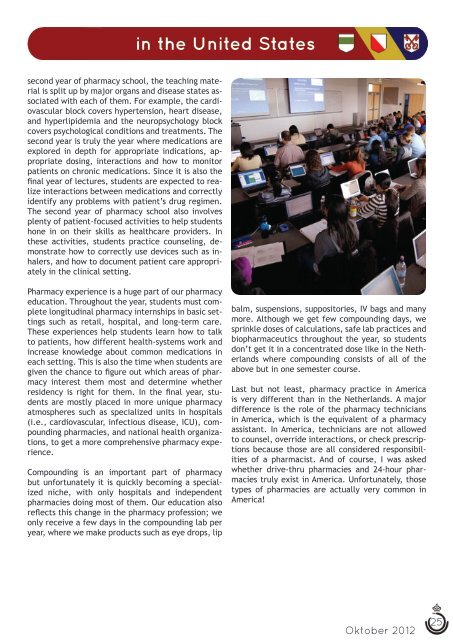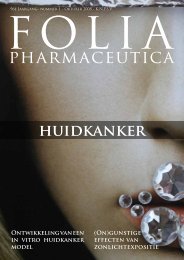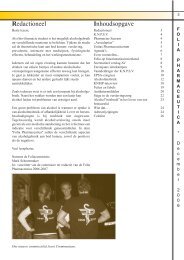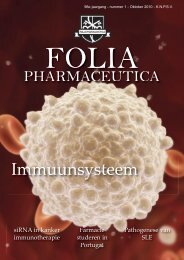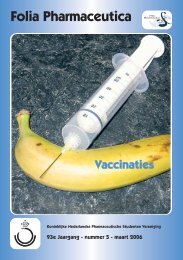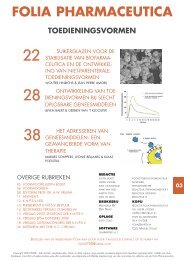Folia jaargang 100 - Nr.1 - Koninklijke Nederlandse ...
Folia jaargang 100 - Nr.1 - Koninklijke Nederlandse ...
Folia jaargang 100 - Nr.1 - Koninklijke Nederlandse ...
You also want an ePaper? Increase the reach of your titles
YUMPU automatically turns print PDFs into web optimized ePapers that Google loves.
second year of pharmacy school, the teaching material<br />
is split up by major organs and disease states associated<br />
with each of them. For example, the cardiovascular<br />
block covers hypertension, heart disease,<br />
and hyperlipidemia and the neuropsychology block<br />
covers psychological conditions and treatments. The<br />
second year is truly the year where medications are<br />
explored in depth for appropriate indications, appropriate<br />
dosing, interactions and how to monitor<br />
patients on chronic medications. Since it is also the<br />
final year of lectures, students are expected to realize<br />
interactions between medications and correctly<br />
identify any problems with patient’s drug regimen.<br />
The second year of pharmacy school also involves<br />
plenty of patient-focused activities to help students<br />
hone in on their skills as healthcare providers. In<br />
these activities, students practice counseling, demonstrate<br />
how to correctly use devices such as inhalers,<br />
and how to document patient care appropriately<br />
in the clinical setting.<br />
Pharmacy experience is a huge part of our pharmacy<br />
education. Throughout the year, students must complete<br />
longitudinal pharmacy internships in basic settings<br />
such as retail, hospital, and long-term care.<br />
These experiences help students learn how to talk<br />
to patients, how different health-systems work and<br />
increase knowledge about common medications in<br />
each setting. This is also the time when students are<br />
given the chance to figure out which areas of pharmacy<br />
interest them most and determine whether<br />
residency is right for them. In the final year, students<br />
are mostly placed in more unique pharmacy<br />
atmospheres such as specialized units in hospitals<br />
(i.e., cardiovascular, infectious disease, ICU), compounding<br />
pharmacies, and national health organizations,<br />
to get a more comprehensive pharmacy experience.<br />
Compounding is an important part of pharmacy<br />
but unfortunately it is quickly becoming a specialized<br />
niche, with only hospitals and independent<br />
pharmacies doing most of them. Our education also<br />
reflects this change in the pharmacy profession; we<br />
only receive a few days in the compounding lab per<br />
year, where we make products such as eye drops, lip<br />
in the United States<br />
balm, suspensions, suppositories, IV bags and many<br />
more. Although we get few compounding days, we<br />
sprinkle doses of calculations, safe lab practices and<br />
biopharmaceutics throughout the year, so students<br />
don’t get it in a concentrated dose like in the Netherlands<br />
where compounding consists of all of the<br />
above but in one semester course.<br />
Last but not least, pharmacy practice in America<br />
is very different than in the Netherlands. A major<br />
difference is the role of the pharmacy technicians<br />
in America, which is the equivalent of a pharmacy<br />
assistant. In America, technicians are not allowed<br />
to counsel, override interactions, or check prescriptions<br />
because those are all considered responsibilities<br />
of a pharmacist. And of course, I was asked<br />
whether drive-thru pharmacies and 24-hour pharmacies<br />
truly exist in America. Unfortunately, those<br />
types of pharmacies are actually very common in<br />
America!<br />
Oktober 2012<br />
25


